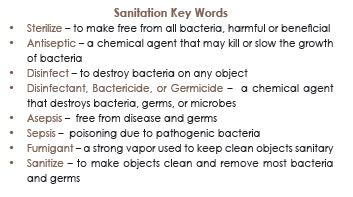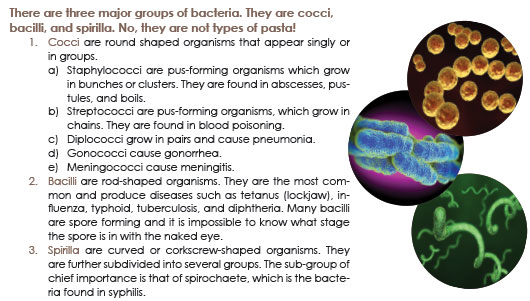 Many times we might think that when we clean something, it is actually sanitized or sterilized, but there is much more involved in proper sanitary protocol. There is a significant difference between something being clean, sanitized, disinfected, and sterile. If an implement, surface, or your hands are not properly and thoroughly sterilized or disinfected, cross-contamination is very possible and could lead to a bad reputation, injured clients, or lawsuits. One of the first things a boxing referee says to the boxers in the ring is, “Protect yourself at all times.” The same is true for aestheticians.
Many times we might think that when we clean something, it is actually sanitized or sterilized, but there is much more involved in proper sanitary protocol. There is a significant difference between something being clean, sanitized, disinfected, and sterile. If an implement, surface, or your hands are not properly and thoroughly sterilized or disinfected, cross-contamination is very possible and could lead to a bad reputation, injured clients, or lawsuits. One of the first things a boxing referee says to the boxers in the ring is, “Protect yourself at all times.” The same is true for aestheticians.
Bacteria
What exactly are bacteria and why are we trying to kill it? There are many different types of bacteria and although some types are very good for the body and environment, in a spa there is no way for us to know which bacteria on our implements are good and which are bad. For cleaning purposes, it is always better to be safe than sorry. The main problem with bacteria is that we cannot see it. It would take roughly 1,500 rod-shaped bacterium to barely reach across a pinhead, which really makes you think about cleaning in a whole new light. Non-pathogenic bacteria are not harmful to people, while pathogenic bacteria spreads disease and also includes parasites.
I like to think of bacteria in terms of the movie The Terminator, almost impossible to kill, and they keep coming back stronger than before. At the end of the day, after cleaning, I can hear the bacilli saying, “I’ll be back.” Once you get that visual, you and your staff will be more likely to take sanitation seriously. Below is a list of pathogenic bacteria, just to give an idea of what we are combating in the treatment rooms, as well as on handles, phones, and reception area.
 Terminator bacteria like warm, dark, damp places to grow and reproduce. This is also where it will feed and form spores when active. The human body is actually a perfect breeding ground and from one bacterium, as many as 16 million more may develop in less than 24 hours. This is why it is so important to constantly be cleaning and moving furniture around to get in those dark spaces we might think are clean. Even when conditions are not favorable, some bacteria are so strong they can withstand periods without food and resist disinfectants.
Terminator bacteria like warm, dark, damp places to grow and reproduce. This is also where it will feed and form spores when active. The human body is actually a perfect breeding ground and from one bacterium, as many as 16 million more may develop in less than 24 hours. This is why it is so important to constantly be cleaning and moving furniture around to get in those dark spaces we might think are clean. Even when conditions are not favorable, some bacteria are so strong they can withstand periods without food and resist disinfectants.
Fungi
If bacteria were not enough, there are also fungi which we need to protect ourselves against. Fungi are actually closer to the animal family than plant family, but are considered their own separate category. This would consist of mold, mildew, and yeast. Unlike some bacteria, they are incapable of manufacturing their own food and usually act as parasites. In humans, we often see fungi as athlete’s foot and ringworm, which is why it is best to wear gloves when working on people’s feet.
Bacteria Lifespan
Just how long can bacteria live? Each type has different survival capabilities, but most all of them need moisture to increase survival rates. Cold viruses can live for a little longer than a week and do better on a non-porous surface. If on the hands, cold viruses generally last a few minutes to less than two hours. The flu virus can last for several hours in the air and the lower the temperature, the longer they last. Salmonella can survive up to four hours on a hard surface or fabric and when someone with the norovirus vomits, the virus becomes airborne, so it is very important to clean nearby surfaces. Herpes viruses from cold sores can survive for four hours on plastic, three hours on cloth, and two hours on the skin. A sneeze can spread bacteria and viruses as far as three feet! The anthrax bacteria can multiply and survive 10 to hundreds of years. When cleaning, we have no idea what kind of bacteria or virus might be lurking, so it is best to take necessary precautions.
 Cleaning the Spa
Cleaning the Spa
The most common thing we will do in a spa is clean. Clean at the beginning of the day, in between clients, during downtime, and at the end of the day. Then we go home and wonder if we cleaned the wax pot before we left! Cleaning removes basic dirt and dust from the surface of something. Cleaning is great, but do not be fooled. Clean surfaces are not necessarily sanitized, which is probably our real intention when cleaning. When something is sanitized, many of the microbes are killed and/or reduced to a level where they cannot reproduce and spread. We are usually trying to kill staphylococcus and Escherichia coli, which are common and easily transferred to other people and surfaces. Items are sanitized by using chemical cleaners or high heat. On a side note, the level of heat in a wax pot is not near where it needs to be to kill microbes, let alone blood and hair left behind. A dry sanitizer is an airtight cabinet that houses an active fumigant. The sanitized implements are kept clean by placing them in a cabinet until ready for use. Beauty distributors sell small fumigant containers filled with Formalin that can be kept in every closed cabinet that has supplies that are used on customers. You can also make your own fumigant. Be very careful and do this in a well-ventilated area. Here is how:
- Mix one tablespoonful of borax and one tablespoonful of Formalin.
- Put them in a small open container or have the container closed.
- Poke holes in the top to let the fumes out.
Replace chemicals regularly as they lose their strength, depending on how often the cabinet door is opened and closed. Depending on the strength of the concentration, Formalin can be used as an antiseptic or disinfectant, which makes it very versatile. Personally, I am not a fan of Formalin because of the fumes. Many people can smell the fumes. Because breathing them can bother the throat, many spas have abandoned this method.
Disinfection is the removal of microbes on implements by submerging them in an Environmental Protection Agency-approved chemical that kills vegetative and growing bacteria, but does not kill resistant bacterial and viral spores. It is very important to follow the instructions on the package in order to fully disinfect. Many solutions require 10 to 20 minutes of complete submersion to disinfect. Sterilization kills all forms of bacterial and viral spores and fungi. It can be done through steam (like an autoclave) or through an Environmental Protection
Agency-approved solution that the implements will be submerged in for hours or a pre-determined length of time, based on the manufacturer’s instructions. An ultraviolet cabinet is a very easy way to store sterilized items, and clients like to see that their makeup brushes, nail files, or tweezers come out of the ultraviolet cabinet. While doing eyelash extensions, I have a few sets of tweezers that I rotate in the ultraviolet sterilizer for each client. Conjunctivitis (pink eye) is highly contagious and most people do not know they have it until it shows visible signs. Another advantage is that an ultraviolet sterilizer will not rust or corrode metal. If you are working with cancer clients, doing permanent makeup, or have many stylists, it might be worthwhile to invest in a hospital-grade autoclave to sterilize all implements.
Think about your work station in terms of how you clean, as well as your personal experiences as a customer. Cross-contamination is so easy. Most stylists use the Barbicide solution incorrectly. In order for it to work, a tool must be washed in soap and water and then placed in the solution. It also must be changed every day or else it is too contaminated to sanitize. Although many spas follow proper Barbicide protocol, personally, I have never seen a hair stylist wash each comb and brush in between every client, place them in Barbicide, and then use a new set of styling tools. I have also never seen the jars cleaned and emptied at the end of each workday. If it is only done on a weekly basis, by then, it is too late. It might behoove clients to start bringing their own comb and brush to the salon. Think about nail files, clippers, makeup brushes, nail buffers, and so on. These items are traditionally not sterilized, let alone disinfected between clients or at the end of the day. It is scary when you really think about how susceptible we are to infection. Now think about that cut, scrape, or open cuticle every time you rub your eyes, nose, or bite your fingernail. Did you know that emery boards cannot be sterilized? This might be a good time for clients to develop obsessive-compulsory disorder or become a germaphobe!
Not only is the sanitizing and sterilization process important, the storage of those implements is just as important. They must be kept in a covered and labeled container, so that no cross-contamination can occur. Look for Environmental Protection Agency-registered,
hospital-grade disinfectant that is bactericidal, viruscidal, fungicidal, and pseudomonacidal. It is also important to thoroughly wash your hands before touching those newly sterilized implements. Depending on the chemicals you are using to clean, it might be beneficial to wear goggles to protect the eyes from any solution splashing up into the face. I would suggest finding your “clean freak” staff member and make them the official cleansing agent of the spa. They can be responsible for making sure there are always enough cleaning supplies, sterilization units are working, and that staff is properly sanitizing implements. Imagine your customers overhearing staff ask for the cleansing agent or telling the cleansing agent to take her combs to be disinfected. This will really impress them and show your clients you care about them and their health. At the front desk, as well as in the staff backroom, there should be a sanitation manual, with protocol and procedures for staff to read through on their downtime. I would also recommend giving one to each staff member upon being hired, having them each sign off upon receiving it, and quizzed randomly. This might seem overboard, given the traditional amount of time given to sanitation in most spas, but it only takes one person getting injured or a disease to ruin your precious reputation and destroy your spa.
 Tips for Sanitizing
Tips for Sanitizing
 Here are a few tips to make sure that your stations and implements are thoroughly sanitized, disinfected, or sterilized.
Here are a few tips to make sure that your stations and implements are thoroughly sanitized, disinfected, or sterilized.
- Wash used towels in hot water and when clean, keep in a closed compartment.
- Sanitize cell phones, desk phones, coffee pots, doorknobs, and handles.
- Have an ultraviolet sterilizer cabinet in every room or near all stations.
- Never double-dip into wax, mascara, lip gloss, et cetera.
- Sharpen and clean makeup pencils between clients.
- Scrape lipstick onto a clean palate and apply lipstick or gloss from the palate. Never go back to the lipstick from the brush.
- Use plastic liners in certain pedicure bowls and replace between each client.
- It will take approximately 20 to 25 minutes to properly disinfect whirlpool pedicure bowls between each client.
- Premix disinfectants so they are easily available and more likely to be used.
- Thoroughly train staff and reinforce proper protocols.
- Hairstylists should have many sets of combs and brushes to be sanitized between each client.
- Shampoo bowls should be sanitized before every client.
- Metal hairstyling tools should be thoroughly sanitized between each client.
- Bacteria can live on money for weeks.
- Sponges are a breeding ground for bacteria.
Disinfectant “quats” (quaternary ammonium compounds) or “super quats” are safe and destroy bacteria quickly. Most super quats will disinfect your instruments in 10 to 15 minutes. You can also use quats disinfectants to clean most surface work areas.
Invest in organic or good smelling cleansing solutions so that staff will use it more. When clients ask why it smells so good, you get to tell them that it is your cleaner. Every time they smell it, they will know you were cleaning and that makes for a happy client. If you are a spa owner, manager, or therapist, proper procedures will save you money in lost clients and fines, while making you money with returning clients and a good reputation. Cleaning hands in soap and water is more effective than hand sanitizers. There must be 70 percent alcohol in order to sanitize and hand sanitizers only have approximately 65 percent alcohol. Studies done with hand sanitizers have only been done on hard surfaces and not on hands, which react and hold bacteria differently. Nothing beats soap and water. I only use 99 percent alcohol in my spa.
Reinforce the three levels of decontamination with your staff: sanitized, disinfected, and sterilized. Sanitized is the lowest level where most micro-organisms are killed. Disinfection destroys micro-
organisms and most disease causing pathogens. Sterilization is a multi-step process that kills all bacterial
and viral spores. Always follow the manufacturer’s guidelines for using chemicals, as well as your state board’s regulations for sanitation. Remember to have your facility properly ventilated with clean vents to absorb potential airborne bacteria. Sick staff and customers can wreck havoc in a business and make people sick. It is better to reschedule and keep everyone healthy. A clean spa is a healthy spa!
To be in compliance and for ways to fight contamination, visit The Centers for Disease Control and Protection, www.cdc.gov or your state board’s website.
 Lora Condon, The Beauty Buster, is a national award-winning aesthetician and a beauty consumer advocate. InStyle Magazine featured her as the “Best Eyebrow Shaper in New Jersey,” and she has been featured on Dr. Oz as a leading beauty insider. Condon excels at helping spas creatively market themselves for immediate results. Her book, SPA WARS: The Ugly Truth About The Beauty Industry received rave write-ups in the New York Times, many beauty blogs, and trade magazines.
Lora Condon, The Beauty Buster, is a national award-winning aesthetician and a beauty consumer advocate. InStyle Magazine featured her as the “Best Eyebrow Shaper in New Jersey,” and she has been featured on Dr. Oz as a leading beauty insider. Condon excels at helping spas creatively market themselves for immediate results. Her book, SPA WARS: The Ugly Truth About The Beauty Industry received rave write-ups in the New York Times, many beauty blogs, and trade magazines.
www.makeupwithme.com
Want to read more?
Subscribe to one of our monthly plans to continue reading this article.